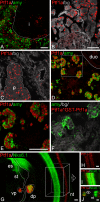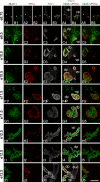Generation and characterization of Ptf1a antiserum and localization of Ptf1a in relation to Nkx6.1 and Pdx1 during the earliest stages of mouse pancreas development
- PMID: 18347078
- PMCID: PMC2386769
- DOI: 10.1369/jhc.2008.950675
Generation and characterization of Ptf1a antiserum and localization of Ptf1a in relation to Nkx6.1 and Pdx1 during the earliest stages of mouse pancreas development
Abstract
Ptf1a and Pdx1 are critical transcription factors of early pancreatic development, as shown by loss of function studies where lack of each gene alone causes almost complete pancreas agenesis. Ptf1a is particularly interesting because it is linked to a recently reported signature gene expression profile associated with the multipotent condition. Few useful antibody reagents have been available for consistent and reliable immunohistochemical visualization of Ptf1a protein expression in the early developing pancreas in which the level of production of this critical regulator seems to be very low. We describe a novel rabbit antibody raised against the c-terminal portion of the mouse Ptf1a protein and report immunodetection, for the first time, as early as embryonic day (e) 8.5-e8.75 in the dorsal and ventral buds of the mouse pancreas as well as in the neural tube at e10.0. Detailed confocal analysis identifies an abundant triple-positive (Ptf1a(+)/Nkx6.1(+)/Pdx1(+)) putative early multipotent pancreatic progenitor cell that marks the e9.5 dorsal pancreas and e10.5 ventral pancreas. Furthermore, expression patterns of Nkx6.1 vs Ptf1a subsequently segregate during branching morphogenesis (trunk vs tip), ending up marking two distinct cell populations of progenitors at e12.5. From e15.5 (mouse) and in adult pancreas (mouse, rat, and human), the Ptf1a antibody marks only acinar cell nuclei, as expected for its subsequent role in committing/maintaining cells in this differentiated state. In summary, this antibody is a novel tool to further characterize important early steps of pancreas differentiation. This manuscript contains online supplemental material at http://www.jhc.org. Please visit this article online to view these materials.
Figures



References
-
- Adell T, Gomez-Cuadrado A, Skoudy A, Pettengill OS, Longnecker DS, Real FX (2000) Role of the basic helix-loop-helix transcription factor p48 in the differentiation phenotype of exocrine pancreas cancer cells. Cell Growth Differ 11:137–147 - PubMed
-
- Ahnfelt-Ronne J, Jorgensen MC, Hald J, Madsen OD, Serup P, Hecksher-Sorensen J (2007) An improved method for 3D reconstruction of protein expression patterns in intact mouse and chicken embryos and organs. J Histochem Cytochem 55:925–930. Published online May 3, 2007. 10.1369/jhc.7A7226 - PubMed
-
- Candia AF, Wright CV (1996) Differential localization of Mox-1 and Mox-2 proteins indicates distinct roles during development. Int J Dev Biol 40:1179–1184 - PubMed
Publication types
MeSH terms
Substances
Grants and funding
LinkOut - more resources
Full Text Sources
Other Literature Sources
Molecular Biology Databases

